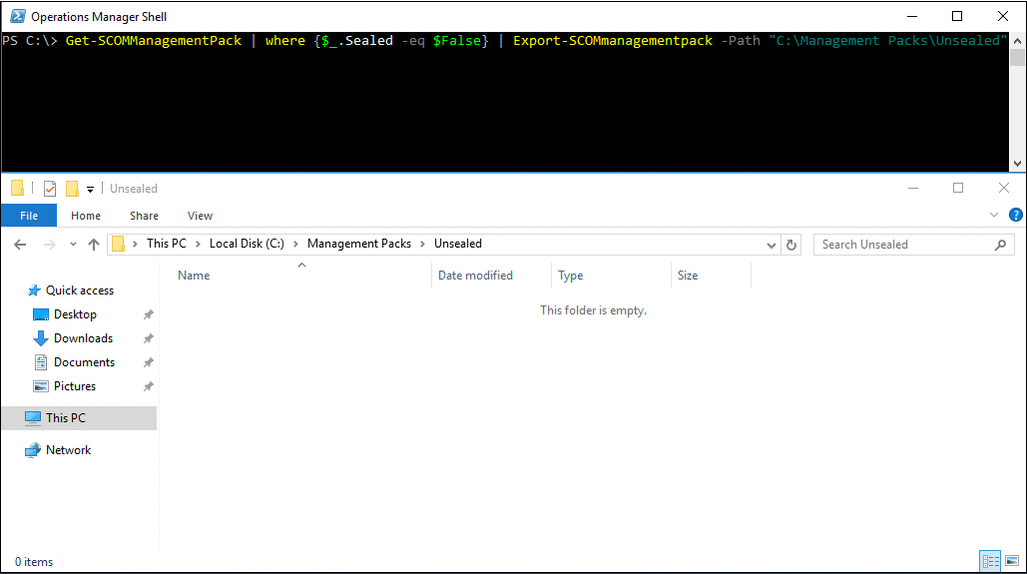10 Useful SCOM PowerShell Scripts
System Center Operations Manager (SCOM) comes with a good PowerShell module, there are many occasions where you want something done quick and easy.
There are a total of 183 different PowerShell cmdlets in the SCOM 2019 PowerShell module, that already speaks for itself how much you can do with this PowerShell module!
This blog post will provide an example for most commands, if you do not see the examples clearly, it's suggested you open the GIF in another browser tab.
Note: Some of the SCOM PowerShell cmdlets below are not found in the Microsoft documentation page for the System Center PowerShell 2016, these scripts have been tested to work with the following SCOM versions: 2016, 1801, 1807 and 2019.
Contents
Exporting sealed management packs
Exporting unsealed management packs
Setting a windows computer into maintenance mode
Retrieve the maintenance mode history for a windows computer
Enable the proxy for all SCOM agents
Retrieve all SCOM agents that are grayed out or unavailable
Retrieve all the SCOM alerts within the last day (highest priority first)
Retrieve all the subscriptions that a specific subscriber belongs to
Export all the SCOM agents to a CSV
Retrieve the amount of agents reporting to a SCOM Management / Gateway Server
Exporting sealed management packs
Get-SCOMManagementPack | where {$_.Sealed -eq $True } | Export-SCOMManagementpack -Path "C:\Management Packs\Sealed"
Example:
Exporting unsealed management packs
Get-SCOMManagementPack | where {$_.Sealed -eq $False} | Export-SCOMManagementpack -Path "C:\Management Packs\Unsealed"
Example:
Setting a windows computer into maintenance mode
$Agent = "yourcomputer.domain.com" $Time = (Get-Date).addMinutes(60) $Instance = (Get-SCOMClass -DisplayName "Windows Computer" | Get-SCOMClassInstance | ? { $_.DisplayName -eq $Agent} ) Start-SCOMMaintenanceMode -Instance $Instance -EndTime $Time -Comment "Maintenance Mode started!" -Reason "PlannedOther"
Example:
Retrieve the maintenance mode history for a windows computer
Get-SCOMMaintenanceMode -Instance (Get-SCOMClassInstance -Class (Get-SCOMClass -Name "Microsoft.Windows.Computer") | Where-Object {$_.DisplayName -match "Your Computer Name"}) -History -ErrorAction SilentlyContinue
Example:
Enable the proxy for all SCOM agents
Get-SCOMAgent | where {$_.ProxyingEnabled -match "False"} | Enable-SCOMAgentProxy
Retrieve all SCOM agents that are grayed out or unavailable
$Agent = Get-SCOMClass -Name "Microsoft.SystemCenter.Agent" $GrayAgents = Get-SCOMMonitoringObject -class $Agent | where {$_.IsAvailable –eq $False} $GrayAgents
Example:
Retrieve all the SCOM alerts within the last day (highest priority first)
$Date = (Get-Date).AddDays(-1) (Get-SCOMAlert -Criteria 'ResolutionState = "0"' | Where-Object {$_.LastModified -gt $Date }) | Sort-Object Priority -Descending
Resolution States
0 = New
255 = Closed
Severity Values for Alerts
0 = Informational
1 = Warning
2 = Critical
Example:
Retrieve all the subscriptions that a specific subscriber belongs to
Get-SCOMNotificationSubscription | ForEach { $Subscriber = $_.DisplayName $_.ToRecipients | foreach { If ($_.Name -Like "*Enter Name Here*") { Write-Host $Subscriber } } }
Example:
Export all the SCOM agents to a CSV
Get-SCOMAgent | Select DisplayName, ManagementGroup, Version, ProxyingEnabled | Export-Csv -NoType C:\SCOMAgents.csv
Example:
Retrieve the amount of agents reporting to a SCOM Management / Gateway Server
$MgmtServer = Get-SCOMManagementServer | where { $_.DisplayName -eq "yourSCOMmanagementserver.domain.com" } $TotalAgents = (Get-SCOMAgent -ManagementServer $MgmtServer).count $TotalAgents
Example:
Note: If you need to retrieve the amount of agents that are reporting to a SCOM Gateway server, change the DisplayName to the SCOM Gateway server name (without FQDN).










